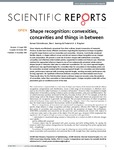Shape recognition: Convexities, concavities and things in between
| dc.contributor.author | Schmidtmann, Gunnar | |
| dc.contributor.author | Jennings, BJ | |
| dc.contributor.author | Guimond, S | |
| dc.contributor.author | Kingdom, FAA | |
| dc.date.accessioned | 2017-11-16T17:26:00Z | |
| dc.date.available | 2017-11-16T17:26:00Z | |
| dc.date.issued | 2014-12-29 | |
| dc.identifier.issn | 1534-7362 | |
| dc.identifier.issn | 1534-7362 | |
| dc.identifier.uri | http://hdl.handle.net/10026.1/10185 | |
| dc.description.abstract |
Visual objects are effortlessly recognized from their outlines, largely irrespective of viewpoint. Previous studies have drawn different conclusions regarding the importance to shape recognition of specific shape features such as convexities and concavities. However, most studies employed familiar objects, or shapes without curves, and did not measure shape recognition across changes in scale and position. We present a novel set of random shapes with well-defined convexities, concavities and inflections (intermediate points), segmented to isolate each feature type. Observers matched the segmented reference shapes to one of two subsequently presented whole-contour shapes (target or distractor) that were re-scaled and re-positioned. For very short segment lengths, performance was significantly higher for convexities than for concavities or intermediate points and for convexities remained constant with increasing segment length. For concavities and intermediate points, performance improved with increasing segment length, reaching convexity performance only for long segments. No significant differences between concavities and intermediates were found. These results show for the first time that closed curvilinear shapes are encoded using the positions of convexities, rather than concavities or intermediate regions. A shape-template model with no free parameters gave an excellent account of the data. | |
| dc.format.extent | 50-50 | |
| dc.language | eng | |
| dc.language.iso | eng | |
| dc.publisher | Association for Research in Vision and Ophthalmology (ARVO) | |
| dc.relation.isreplacedby | 10026.1/10190 | |
| dc.relation.isreplacedby | http://hdl.handle.net/10026.1/10190 | |
| dc.title | Shape recognition: Convexities, concavities and things in between | |
| dc.type | conference | |
| plymouth.author-url | https://www.ncbi.nlm.nih.gov/pubmed/26598139 | |
| plymouth.issue | 15 | |
| plymouth.volume | 14 | |
| plymouth.publication-status | Published | |
| plymouth.journal | Journal of Vision | |
| dc.identifier.doi | 10.1167/14.15.50 | |
| plymouth.organisational-group | /Plymouth | |
| plymouth.organisational-group | /Plymouth/00 All current users | |
| plymouth.organisational-group | /Plymouth/00 All current users/Academics | |
| plymouth.organisational-group | /Plymouth/00 All current users/Academics/Faculty of Health & Human Sciences | |
| plymouth.organisational-group | /Plymouth/00 All current users/Academics/Faculty of Health & Human Sciences/School of Health Professions | |
| plymouth.organisational-group | /Plymouth/Faculty of Health & Human Sciences | |
| plymouth.organisational-group | /Plymouth/Faculty of Health & Human Sciences/School of Health Professions | |
| dc.publisher.place | England | |
| dc.publisher.place | England | |
| dcterms.dateAccepted | 2015-10-26 | |
| dc.identifier.eissn | 1534-7362 | |
| rioxxterms.versionofrecord | 10.1167/14.15.50 | |
| rioxxterms.licenseref.uri | http://www.rioxx.net/licenses/all-rights-reserved | |
| rioxxterms.licenseref.startdate | 2015-11-24 | |
| rioxxterms.type | Journal Article/Review |


